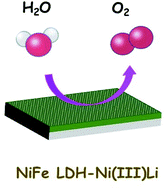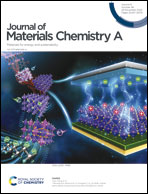Engineering NiFe layered double hydroxide by valence control and intermediate stabilization toward the oxygen evolution reaction†
Abstract
NiFe layered double hydroxide (LDH) is one of the most promising candidates for oxygen evolution reaction (OER) electrocatalysts. However, it is still challenging to design NiFe LDH with both high activity and good stability. Herein, NiFe LDH-Ni(III)Li is synthesized by a facile approach through valence control of Ni ions and selective doping of Li. Ni(III) ion percentage is significantly increased from less than 60% to 72.5% in the LDH thanks to the combined benefits of electrochemical oxidation, Mo-leaching and Li-doping. The catalytic activity of NiFe LDH-Ni(III)Li is greatly promoted because the eg electron occupancy of Ni3+ approaches one, producing optimal bond strength with O. Moreover, density functional theory calculations reveal that Li-doping reduces the adsorption energy difference between *OOH and *OH from 3.16 eV to 2.79 eV by the stabilization of *OOH, decreasing the energy barrier of the rate-determining step by 0.29 eV. At the same time, higher covalency of Ni–O bonds results from the enlarged overlap between Ni 3d and O 2p orbitals, further enhancing the OER kinetics. Consequently, NiFe LDH-Ni(III)Li exhibits excellent OER performance (overpotential of 248 mV at 10 mA cm−2 on a flat current collector). This work provides a promising technique for engineering the electronic structure of LDH toward outstanding OER properties.



 Please wait while we load your content...
Please wait while we load your content...